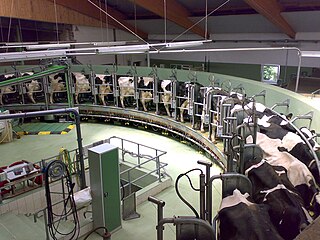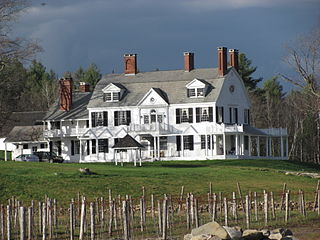
Chazy is a town in northeastern Clinton County, New York, United States. The population was 4,284 at the 2010 census. The closest city is Plattsburgh, 14 miles (23 km) to the south. Chazy is 8 miles (13 km) south of the Canada–United States border. The ZIP code is 12921 and the community is in area code 518.

The University of Vermont (UVM), officially titled as University of Vermont and State Agricultural College, is a public land-grant research university in Burlington, Vermont. Founded in 1791, the university is the oldest in Vermont and the fifth-oldest in New England, making it among the oldest in the United States. It is one of the original eight Public Ivies.

The Ontario Agricultural College (OAC) originated at the agricultural laboratories of the Toronto Normal School, and was officially founded in 1874 as an associate agricultural college of the University of Toronto. Since 1964, it has become affiliated with the University of Guelph, which operates campuses in Guelph and Ridgetown and formerly in Alfred and Kemptville, all in Ontario.

Dairy farming is a class of agriculture for the long-term production of milk, which is processed for the eventual sale of a dairy product. Dairy farming has a history that goes back to the early Neolithic era, around the seventh millennium BC, in many regions of Europe and Africa. Before the 20th century, milking was done by hand on small farms. Beginning in the early 20th century, milking was done in large scale dairy farms with innovations including rotary parlors, the milking pipeline, and automatic milking systems that were commercially developed in the early 1990s.

The New York State College of Veterinary Medicine at Cornell University is a college of veterinary medicine at Cornell University, in Ithaca, New York. It was founded in 1894. It is the first statutory college of the State University of New York (SUNY) system.

Burleigh H. Murray Ranch is a property in the state park system of California in the United States. It is a valley ranch located in San Mateo County inland from Half Moon Bay. The ranch was established in 1857 and became a 1,325-acre (536 ha) park in 1979. It was purchased by the State of California in 1983.
The Cabot Creamery Cooperative is an American dairy agricultural marketing cooperative owned by Agri-Mark. The cooperative has a plant in Cabot, Vermont, but its administrative headquarters is in Waitsfield, Vermont.

Sugar Mountain Farm is a 70 acres (28 ha) family-operated pig farm in West Topsham, Vermont with approximately 200-400 pastured-raised pigs. The pigs are fed acid whey from a nearby dairy farm, apple pomace leftovers from a nearby cider facility, vegetables, and spent barley from a brewery as opposed to grain.

Valcour Island is a 968-acre (3.92 km2) island in Lake Champlain in Clinton County, New York, United States. The island is mostly in the Town of Peru and partly in the Town of Plattsburgh, southeast of the City of Plattsburgh. It is within the boundaries of the Adirondack Park.

Brook Farm is a historic country estate farm at 4203 Twenty Mile Stream Road in Cavendish, Vermont. It includes one of the state's grandest Colonial Revival mansion houses, and surviving outbuildings of a model farm of the turn of the 20th century. It was listed on the National Register of Historic Places in 1993. The property is now home to the Brook Farm Vineyard.
Electrical energy efficiency on United States farms covers the use of electricity on farms and the methods and incentives for improving the efficiency of that use.

Morrill Hall is a campus building of the University of Vermont (UVM), which is located on the southeast corner of the "University Green" in Burlington, Vermont. The building was named after U.S. Senator, Justin Smith Morrill who authored the Morrill Land-Grant Acts of 1862 and 1890, which created the American Land-Grant universities and colleges. Senator Morrill also served as a trustee of the university from 1865 until 1898. The building was constructed during 1906–07 to serve as the home of the UVM Agriculture Department and the Agricultural Experiment Station. It was added to National Register of Historic Places as part of University Green Historic District on April 14, 1975. As of 2015, the building continues to house the College of Agriculture and Life Sciences and the UVM Agricultural Extension Service.

The Ezekiel Emerson Farm, also known as Apple Hill Farm, is a historic farm property at 936 Brandon Mountain Road in Rochester, Vermont. Occupying 38 acres (15

Top Acres Farm, known historically as the Fletcher–Fullerton Farm, is a farm property at 1390 Fletcher Schoolhouse Road in Woodstock, Vermont. Developed as a farm in the early 19th century, it was in continuous agricultural use by just two families for nearly two centuries. It was listed on the National Register of Historic Places in 2004.

The Morgan Horse Farm is a historic horse breeding facility at 74 Battell Drive in Weybridge, Vermont. Since 1907, it has been an official breeding site for the Morgan horse, one of the first American-bred horse breeds, and Vermont's official state animal. The breeding program was established in Burlington in 1905, and moved to this site in 1907 by the United States Department of Agriculture, and is now run by the University of Vermont. The farm is listed on the National Register of Historic Places.

Field Farm is a historic farm property on Fuller Mountain Road in Ferrisburgh, Vermont. Developed around the turn of the 19th century, the property includes an early farmhouse and barn, as well as outbuildings representative of Vermont's trends in agriculture over two centuries. The property was listed on the National Register of Historic Places in 1995.
William Henry Miner was an American entrepreneur, industrialist, pioneer and philanthropist. Miner became a wealthy railroad industrialist as the inventor of railcar draft gears. After becoming a successful entrepreneur in Chicago he returned to Chazy, New York. Heart's Delight Farm, the land that would become Miner Institute, was developed by William H. Miner on his family homestead beginning in 1903.
Agriculture is a major component of the New York economy. As of the 2012 census of agriculture, there were over 35,000 farms covering an area of 7 million acres (28,000 km2) which contributed $5.4 billion in gross sales value and $1.2 billion in net farm income to the national economy. Dairy farming alone accounted for $2.5 billion or 45% of sales. The Finger Lakes region is the center of state agriculture, and the state is a top-ten national producer of cow milk, apples, grapes, onions, sweet corn, tomatoes, and maple syrup. New York places second in apples next to Washington.

The Dairy Campus in the Netherlands is a test farm and centre for scientific research and practical training in the field of dairy farming, located, the capital of the province of Friesland. The decision to launch this centre was made in 2011, and it was opened in 2016. The Campus traces its roots to the test farm Bosma Zathe, founded in Ureterp in 1944; its building complex was formerly called Nij Bosma Zathe. Today, the Dairy Campus is part of Wageningen University & Research (WUR). All activities in the centre are focused on the development of sustainable methods for the production and processing of dairy products.
Dairy is a primary source of agricultural output in the state of Vermont. As of December 2021, the state had 568 dairy farms milking cattle, sheep, and/or goats which produced 2.5 billion pounds of milk annually. Vermont ranks 15th in the United States for raw milk production.
















